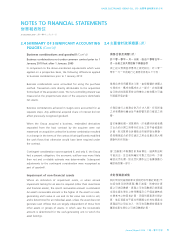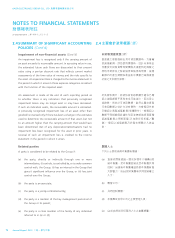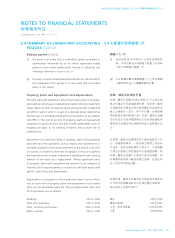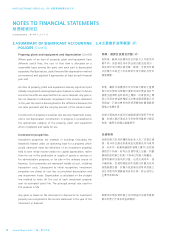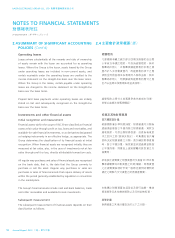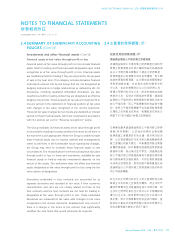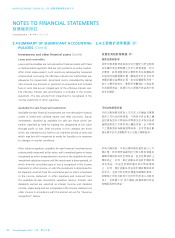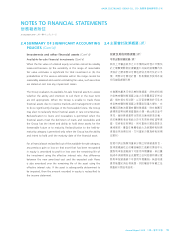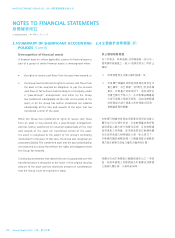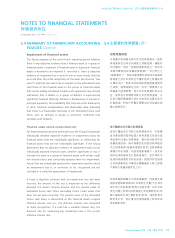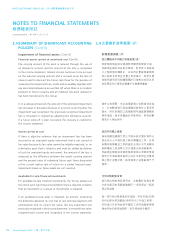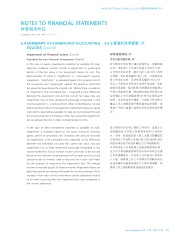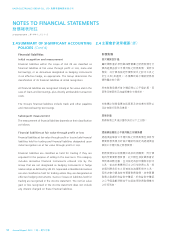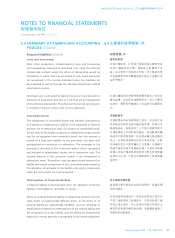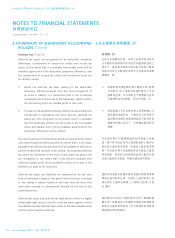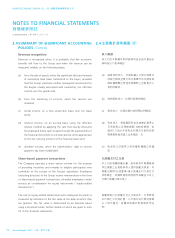Haier 2010 Annual Report Download - page 107
Download and view the complete annual report
Please find page 107 of the 2010 Haier annual report below. You can navigate through the pages in the report by either clicking on the pages listed below, or by using the keyword search tool below to find specific information within the annual report.31 December 2010
二零一零年十二月三十一日
NOTES TO FINANCIAL STATEMENTS
財務報表附註
HAIER ELECTRONICS GROUP CO., LTD 海爾電器集團有限公司
Annual Report 2010 二零一零年年報 105
2.4 SUMMARY OF SIGNIFICANT ACCOUNTING
POLICIES (Cont’d)
Impairment of financial assets
The Group assesses at the end of each reporting period whether
there is any objective evidence that a financial asset or a group of
financial assets is impaired. A financial asset or a group of financial
assets is deemed to be impaired if, and only if, there is objective
evidence of impairment as a result of one or more events that has
occurred after the initial recognition of the asset (an incurred “loss
event”) and that loss event has an impact on the estimated future
cash flows of the financial asset or the group of financial assets
that can be reliably estimated. Evidence of impairment may include
indications that a debtor or a group of debtors is experiencing
significant financial difficulty, default or delinquency in interest or
principal payments, the probability that they will enter bankruptcy
or other financial reorganisation and observable data indicating
that there is a measurable decrease in the estimated future cash
flows, such as changes in arrears or economic conditions that
correlate with defaults.
Financial assets carried at amortised cost
For financial assets carried at amortised cost, the Group first assesses
individually whether objective evidence of impairment exists for
financial assets that are individually significant, or collectively for
financial assets that are not individually significant. If the Group
determines that no objective evidence of impairment exists for an
individually assessed financial asset, whether significant or not, it
includes the asset in a group of financial assets with similar credit
risk characteristics and collectively assesses them for impairment.
Assets that are individually assessed for impairment and for which
an impairment loss is, or continues to be, recognised are not
included in a collective assessment of impairment.
If there is objective evidence that an impairment loss has been
incurred, the amount of the loss is measured as the difference
between the asset’s carrying amount and the present value of
estimated future cash flows (excluding future credit losses that
have not yet been incurred). The present value of the estimated
future cash flows is discounted at the financial asset’s original
effective interest rate (i.e., the effective interest rate computed
at initial recognition). If a loan has a variable interest rate, the
discount rate for measuring any impairment loss is the current
effective interest rate.
2.4 主要會計政策概要
(續)
財務資產減值
本集團於每個報告期末評估財務資產或一組財
務資產有否出現任何減值之客觀證據。僅當於
初步確認一項或一組財務資產後發生一項或多
項事件導致存在客觀減值證據(一項已發生之
「虧損事件」),而該項虧損事件對該項或該組財
務資產之估計未來現金流量所造成之影響能夠
可靠地估計,則該項或該組財務資產會被視作
已減值。減值證據可包括一名或一群債務人正
面臨重大經濟困難、拖欠或未能償還利息或本
金、彼等有可能破產或進行其他財務重組,以
及有可觀察數據顯示估計未來現金流量出現可
計量減損,例如欠款數目變動或出現與違約相
關之經濟狀況。
按已攤銷成本列賬之財務資產
就按已攤銷成本列賬之財務資產而言,本集團
首先會按個別基準就重大財務資產或按組合基
準就個別非重大財務資產,個別評估是否存在
客觀減值證據。倘本集團認定按個別基準經評
估之財務資產(無論具重要性與否)並無客觀證
據顯示存在減值,則該項資產會歸入一組具有
相似信貸風險特性之財務資產內,並共同評估
該組財務資產是否存在減值。經個別評估減值
且其減值虧損已予確認或繼續確認入賬之資產
不會納入集體減值評估之內。
倘有客觀證據顯示出現減值虧損,則減值金額
按該資產賬面值與估計未來現金流量(不包括未
來出現之信貸虧損)現值之差額計量。估計未來
現金流量之現值以財務資產之原始實際利率(即
首次確認時計算之實際利率)貼現。倘貸款按浮
動利率計息,則計量任何減值虧損之貼現率為
現有實際利率。


